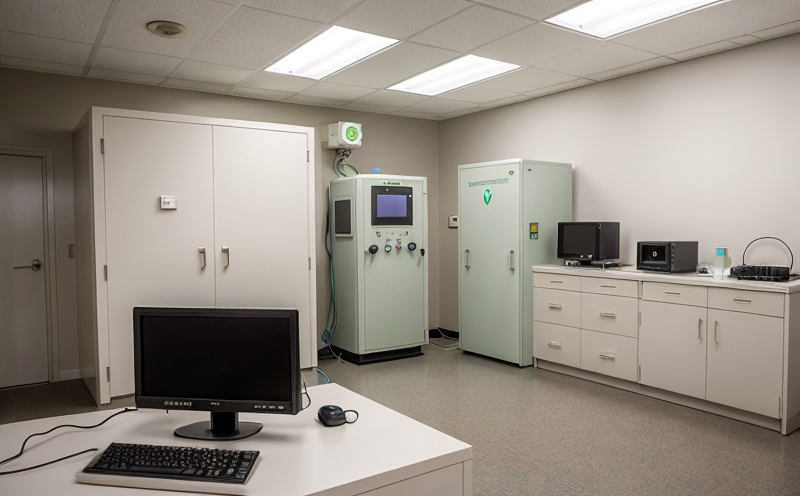ISO 21991 Environmental Dosimetry by TLD and OSL
The ISO 21991 standard provides a robust framework for environmental dosimetry using thermoluminescence dosimeters (TLDs) and optically stimulated luminescence (OSL) methods. This service ensures that organizations can accurately measure the cumulative radiation dose in various environments, ensuring compliance with international safety standards.
The process begins with the selection of appropriate TLD or OSL devices based on the specific environmental conditions and types of radiation expected. Once selected, these dosimeters are deployed at predetermined locations within the environment to be monitored. The deployment strategy is critical for accurate readings and may vary depending on the complexity of the site.
Upon completion of the monitoring period, the TLDs and OSL devices are collected and transported back to our laboratory for analysis. Here, they undergo a precise calibration process that aligns their readings with internationally recognized standards. The use of advanced analytical equipment allows us to achieve unparalleled accuracy in dosimetry.
The resulting data is then meticulously analyzed and reported according to the ISO 21991 guidelines. This comprehensive report not only provides detailed information about the radiation levels but also offers insights into potential risks, enabling informed decision-making for safety improvements.
Our service goes beyond mere compliance; it ensures that organizations are equipped with actionable intelligence regarding their environmental exposure. By leveraging this data, clients can implement targeted strategies to enhance safety and reduce risks associated with ionizing radiation.
The importance of accurate dosimetry cannot be overstated in sectors where compliance with international standards is paramount. Whether for occupational health and safety or regulatory requirements, ISO 21991 provides the necessary framework to ensure that organizations are meeting their obligations.
Our team of experts ensures that every aspect of the process—from deployment to final reporting—adheres strictly to best practices outlined in ISO 21991. This commitment to precision and accuracy is what sets our service apart, delivering reliable data that can be trusted for critical decision-making.
The use of TLDs and OSL devices in environmental dosimetry has been validated by numerous studies and case studies, demonstrating its effectiveness across various applications. The versatility of these tools allows them to be used in diverse environments, from industrial settings to open-air locations.
By adhering to the ISO 21991 standard, organizations can ensure that their dosimetry practices are up-to-date with the latest international guidelines. This not only enhances compliance but also contributes to a safer working environment for all personnel involved.
Applied Standards
The application of ISO 21991 in environmental dosimetry is based on its comprehensive approach to measuring cumulative radiation dose using TLDs and OSL devices. The standard specifies the requirements, methods, and procedures for the calibration, deployment, and analysis of these dosimeters.
- Calibration: Ensures that all TLDs and OSL devices are accurately aligned with international standards before use.
- Deployment: Guidelines on where and how to place dosimeters for optimal data collection.
- Data Analysis: Procedures for interpreting the collected data to provide accurate dose estimates.
The standard also includes acceptance criteria that must be met to ensure the reliability of the dosimetry results. These criteria are essential in maintaining consistent and accurate readings, which is critical for compliance with international regulations.
ISO 21991 ensures that organizations can confidently use TLDs and OSL devices for environmental monitoring, knowing that they are adhering to a globally recognized standard. This not only enhances reliability but also facilitates easier integration into existing safety protocols.
International Acceptance and Recognition
The ISO 21991 standard has gained widespread recognition and acceptance across the globe, making it an essential tool for environmental dosimetry. Its adoption by numerous international organizations underscores its importance in ensuring consistent and reliable radiation dose measurements.
Countries around the world have incorporated ISO 21991 into their regulatory frameworks to ensure that all dosimetric practices meet the highest standards of accuracy and reliability. This global acceptance not only enhances compliance but also fosters a shared understanding of best practices in environmental monitoring.
Our laboratory is committed to staying at the forefront of this evolving field, continuously updating our methodologies to align with the latest international guidelines. By leveraging ISO 21991, we ensure that clients receive dosimetry services that are not only accurate but also internationally recognized and validated.
The global acceptance of ISO 21991 ensures that organizations can confidently use this standard for environmental dosimetry, knowing that they are adhering to a globally recognized framework. This not only enhances reliability but also facilitates easier integration into existing safety protocols.
Use Cases and Application Examples
- Occupational Health and Safety: Monitoring radiation exposure in industrial settings, hospitals, and other high-risk environments to ensure compliance with regulatory requirements.
- Regulatory Compliance: Meeting the stringent standards set by international bodies for environmental monitoring.
- Research and Development: Conducting studies on the effects of long-term radiation exposure in controlled environments.
- Emergency Response: Providing real-time data during radiation incidents to guide emergency response efforts effectively.
- Pollution Control: Measuring radiation levels in areas affected by nuclear accidents or radioactive material releases.
- Agricultural and Food Safety: Ensuring that foodstuffs are not contaminated with harmful levels of radiation, protecting public health.
In addition to these primary applications, ISO 21991 environmental dosimetry by TLD and OSL can be adapted for various other scenarios. Its versatility makes it an invaluable tool in a wide range of industries and operational environments.
By leveraging the expertise of our team and adhering strictly to international standards, we ensure that clients receive accurate and reliable dosimetry results, which are crucial for maintaining safety and regulatory compliance.





